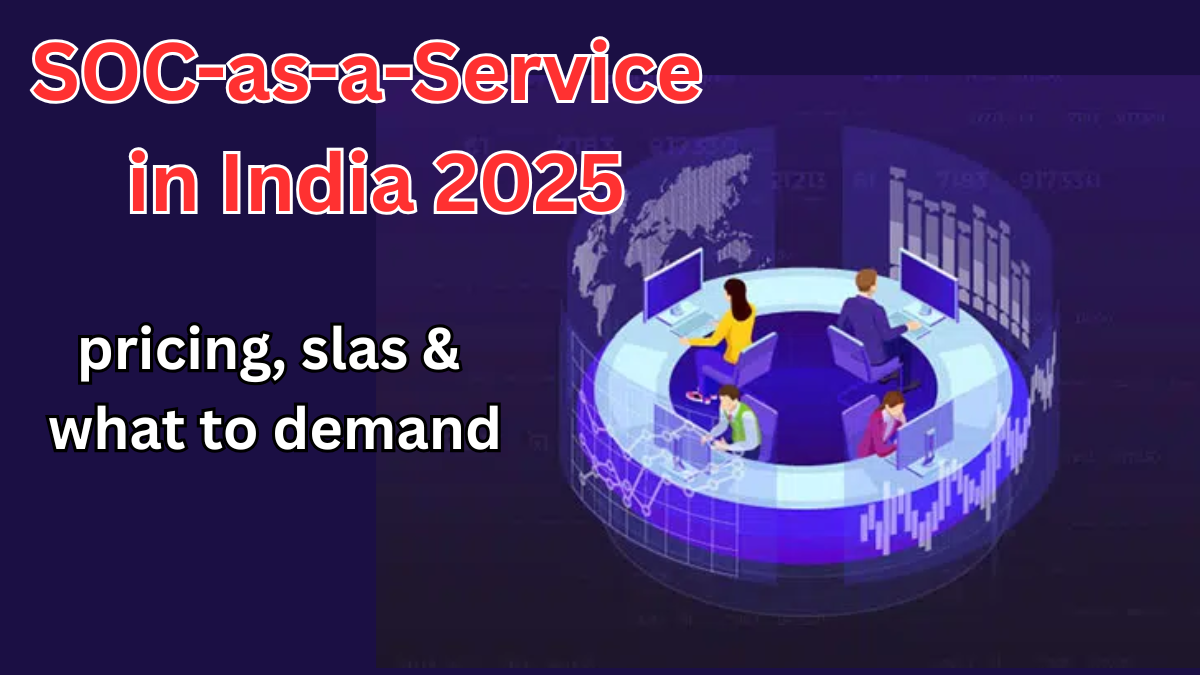In 2025, the cybersecurity landscape in India is evolving faster than ever. Companies, regardless of size, are realizing that protecting digital assets is no longer optional. Enter SOC-as-a-Service India 2025, a model that allows organizations to leverage enterprise-grade Security Operations Center (SOC) capabilities without heavy upfront investments. But what does this service really offer, and what should businesses demand from vendors?

What is SOC-as-a-Service?
SOC-as-a-Service provides outsourced cybersecurity monitoring and response solutions. It’s essentially a cloud-based Security Operations Center that works 24/7 to detect, investigate, and respond to security incidents. Instead of building an in-house team—which can be costly and resource-intensive—businesses can subscribe to SOC services tailored to their needs.
Key benefits include:
-
Round-the-clock monitoring of networks, endpoints, and applications
-
Rapid threat detection and automated response
-
Compliance support for regulations like ISO 27001, GDPR, and local Indian cybersecurity laws
-
Scalable service models suitable for startups to large enterprises
Understanding Pricing for SOC-as-a-Service in India 2025
Pricing for SOC-as-a-Service India 2025 depends on multiple factors, such as the scope of services, number of endpoints, and level of monitoring required. Typically, vendors offer flexible models:
| Pricing Model | Features | Typical Range (INR/month) |
|---|---|---|
| Per Endpoint | Charges based on number of devices monitored | ₹1,500 – ₹5,000 |
| Tiered Packages | Bronze, Silver, Gold packages with varying features | ₹50,000 – ₹3,00,000 |
| Custom | Tailored solutions based on enterprise needs | Negotiable |
Important tips:
-
Compare multiple vendors before finalizing pricing
-
Check if pricing includes incident response and threat intelligence services
-
Confirm hidden costs such as onboarding fees or premium alerts
Service Level Agreements (SLA) – What to Expect
SLAs define the vendor’s commitment to service quality. In 2025, companies should demand clarity on:
-
Response Time: How quickly the SOC reacts to alerts
-
Uptime Guarantees: Ensuring monitoring is uninterrupted
-
Reporting Frequency: Regular insights into threats and resolutions
-
Escalation Process: How major incidents are communicated and handled
Sample SLA Table:
| SLA Component | Standard Expectation |
|---|---|
| Alert Response | Within 15-30 minutes |
| Critical Incident Resolution | 2-4 hours |
| Monitoring Uptime | 99.9% |
| Reports | Weekly / Monthly |
Having a clear SLA ensures accountability and peace of mind for organizations investing in Security Operations Center services.
Key Questions to Ask Your SOC Vendor
When choosing SOC-as-a-Service, ask:
-
Which cybersecurity frameworks do you follow?
-
Can you integrate with our existing IT and cloud infrastructure?
-
Do you provide proactive threat hunting or only reactive services?
-
What level of customization is possible in your SLA and pricing?
These questions help ensure that your investment aligns with business goals and risk tolerance.
Future Outlook for SOC-as-a-Service India 2025
The demand for SOC services in India is expected to grow significantly due to:
-
Increasing cyberattacks targeting SMEs and large enterprises
-
Rise of remote work and cloud adoption
-
Regulatory pressures enforcing stricter cybersecurity measures
Businesses that adopt SOC-as-a-Service India 2025 today are positioning themselves for resilience against evolving threats.
FAQs
Q1: What is the difference between SOC-as-a-Service and a traditional SOC?
A: Traditional SOCs require in-house teams and infrastructure, whereas SOC-as-a-Service is outsourced, cloud-based, and subscription-driven.
Q2: How do pricing models differ across vendors in India?
A: Vendors may charge per endpoint, offer tiered packages, or provide fully customized solutions depending on monitoring scope and response needs.
Q3: Are SLAs negotiable with SOC providers?
A: Yes, most vendors are flexible and will customize SLAs to meet business requirements and regulatory compliance.
Q4: Can SOC-as-a-Service support regulatory compliance in India?
A: Absolutely. Most SOC vendors provide reporting and threat monitoring to help meet standards like ISO 27001, IT Act provisions, and other local regulations
Click here to learn more